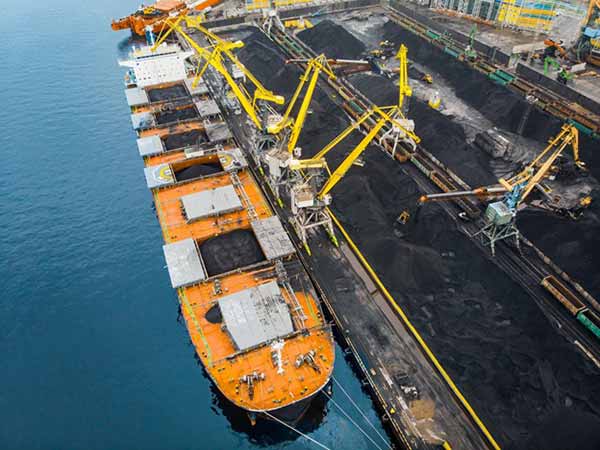Political tension around Ukraine has provided a boom for Russia’s coal producers.
European Union member states’ January coal imports rose by 55.8% compared to the same time last year. According to an analysis by shipbroker Braemar ACM, almost half of that supply — 43.2% — came from Russia and 19.1% from Australia.
In December 2021, EU coal imports also saw an increase of 35.1% year-on-year to 9.3 million tons. The spikes follow a general trend for Europe to import more coal from Russia, with 2021 seeing a 16.2% rise in coal imports from Russia to the EU.
Germany, Belgium, and the Netherlands are the leading destinations for Russia’s European coal exports.
Coal in Favor as Natural Gas Supplies Under Threat
The EU’s switch to coal comes in response to fears Russia may invade Ukraine and disrupt already expensive natural gas supplies. Around 40% of the EU’s natural gas comes from Russia.
At their peak of $6.40 in October 2021, Natural gas prices have more than quadrupled since June 2020, when prices were around $1.40 per MMBTU, or 1 million British Thermal Units. They have traded between $4.00 to $5.40 per MMBTU in February 2022.
Coal’s price has also surged on the back of the energy and natural gas crisis. It peaked at around $270 per ton in October 2021 and is currently at about $240, having rushed upwards from $50 per ton in October 2020.
Governments like France have allowed power plants to burn more coal in 2022 to avoid power outages and keep the lights on.
These factors have created a lucrative market for Russia’s coal exporters, with increased exports at higher prices. The result for customers in Europe and across the world has been massive hikes in energy bills.
Switch to Coal Boosts Carbon Capture Prices
Coal is the dirtiest fossil fuel globally and is responsible for almost one-third of the 1.8 degrees Fahrenheit increase in the world average temperatures already recorded. Its return to power generation has had knock-on effects in Europe’s broader energy market.
The European Union’s emissions trading system (ETS) makes polluting industries pay a set amount for each ton of carbon they produce. Many power plants have recently switched to coal from expensive natural gas for electricity production, pushing up their carbon emissions.
As a result, the ETS’ price reached 96 euros ($109) per ton of carbon last week, its highest value and close to the symbolic price of 100 euros ($114). The EU hopes high prices will force industries to switch to greener energy supplies and encourage more carbon capture schemes.
Indeed, the entire fossil fuel industry finds itself in a state of flux within the EU. The European Commission is currently looking to include natural gas as a “green energy” under new plans. It remains to be seen how any new classification would impact natural gas’s long-term pricing.
Coal’s Return More Than Just Embers in the Fire
In 2019, coal was the world’s second-largest primary energy source at 27%, trailing only oil (33.1%) and more than gas (24.2%). The United Nations thinks coal’s 2019 usage levels need to drop 79% by 2030 to fulfill Paris Agreement pledges.
However, its resilience as a relatively cheap and reliable energy source has been highlighted during the Ukraine standoff. Indeed, regardless of current political affairs, global coal production is expected to increase until 2025.
Big Companies Cash in on Soaring Energy Prices
Astronomic energy prices have helped energy companies return huge profits. BP reported an underlying profit of $4.1 billion in the final quarter of 2021, compared to $115 million a year before. The company made an overall profit of $12.8 billion in 2021 against a $5.7 billion loss in pandemic-affected 2020.
Shell also posted huge gains with a $6.4 billion profit for the final quarter of 2021, against $393 million at the same time the previous year. In 2021, the Dutch company recorded a $19.3 billion profit, up from $4.85 billion in 2020.
How Saving Energy Is the Best Way Forward
Coal has been a clear winner in the fallout from political tension and rising energy prices.
Energy bills globally are expected to remain high for some time, regardless of any resolution in the Russia-Ukraine issue. Closer to home, high prices mean that adopting energy-saving tips is even more critical than ever.
Opinion writer: Tom Shearman
The opinions, beliefs, and viewpoints expressed by the various authors do not necessarily reflect the opinions, beliefs, or viewpoints of Interactive Energy Group, LLC (IEG) or its parent companies or affiliates and may have been created by a third party contracted by IEG. Any content provided by the bloggers or authors are of their opinion and are not intended to malign any individual, organization, company, group, or anyone or anything.
Brought to you by energysavings.com
All images licensed from Adobe Stock.
Featured Image

